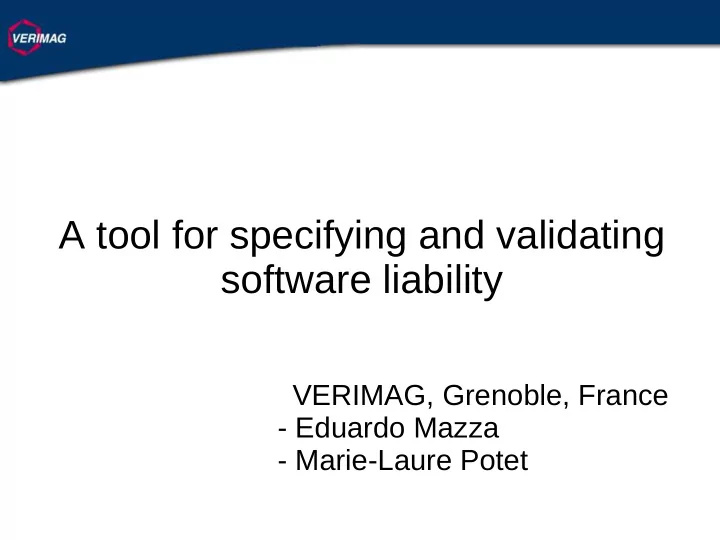

A tool for specifying and validating software liability VERIMAG, Grenoble, France - Eduardo Mazza - Marie-Laure Potet
Outline ● Context ● Approach ● Study Case ● Specifications ● Entities ● Logs ● Properties ● Responsibility ● Future Work ● Conclusions
LISE: L iability I ssues in S oftware E ngineering ● Context ● Multidisciplinary group – Lawyers and Engineers that search to produce a valid solution for legal dispute resolutions based on digital evidences ● Liability – With system more complex is important to know who is responsible ● Example: system that use open-source or third party components ● Digital evidences – What can be legally used as digital evidence? How to formalize it? ● Contract made between legal parts – The main object of LISE – it should contains agreements about liability and digital evidences 3
Specific objective for VERIMAG ● Propose a language for formally describe the liability of legal parts in contracts ● Formal specification of logs as digital evidences ● Define a log analyzer , to determine the responsibility, based on the log, when an error occurs ● Approach: ● Use of B to: – Define contract elements – Define the log analyzer ● Creation of a tool for verification/validation of liability situations ● The log can never be corrupted – the information registered corresponds exactly what it happened 4
Approach 5
Study case ● Signature system in mobile ● Examples of problems: ● User alleges that he has never signed any document ● User alleges that he has signed a document different from the one in server 6
Approach (use of Event B) 7
B to help define the formal model ● Formal model ● Precise log definition and correct/incorrect behavior ● Validation by animation ● Properties verification ● Log accuracy with behavior ● Responsibility function “completeness” – Log contain the minimum information to define responsiblity 8
B for specifying the log analyzer ● Log analyzer: a trusted component for legal parties ● Formal specification ● Proved properties ● Take as input: – Claim – Logs ● Responsibility explanation (analyzer output) ● Who is responsible? ● Why is it responsible? 9
Approach (today) 10
Study case schema 11
Entities ● Entities ● System components (set COMP) – {Server, App, Card, ...) ● Users (set USER) – {Costumer, ECC} ● Legal parties (set PARTY) – {MPP, SAP, ...} ● Model as constants ● Liability function ● liability: ACTOR PARTY ● ACTOR = COMP U USER 12
Logs ● Abstract log: ● Sequence of messages with the order that they were send/received ● One log for each actor (ACTOR) ● Distributed log model alog : ACTOR → seq(OP x ACTOR x ACTION x seq(PARAMETER)) ● OP = {Send, Receive} ● ACTION = {SendDocument, …} ● PARAMETER: represents values transmitted 13
Log Integrity Properties ● Additional information for log ● AC: ACTOR → ACTION – What are the possible actions for each actor ● Some properties that can be verified: ● Verifying actions execution: (Send, sa, ac, pa) ∈ alog(ss) ⇒ (sa, ac) ∈ AC ∈ ⇒ ∈ (Receive, sa, ac, pa) alog(ss) (ss, ac) AC) ● Verifying communication errors (Receive, sa, ac, pa) ∈ alog(ss) ⇒ (Send, ss, ac, pa) ∈ alog(sa) 14
Log Functionality Properties ● We can define all possibles logs that specify the regular system executions for each actor Correct : (ACTOR x LOG) → BOOL ● Function that takes as input actor and associated log and gives as output a boolean that indicates if the log belongs or not to the correct executions ● The correct behaviors are used defining the responsibility function 15
Log Functionality Properties ● Regular behavior can be stated as abstract log properties ● “Every time the user receives a document it should have later a message that says if the user sign or not the document” ∈ (op, ss, ShowDocument, pa) alog(Display) ⇒ (op, ss, SendReponse, pa) ∈ alog(User) ● “Before send the document to sign the same document should be seen by the mobile user” ∈ (op, ss, Sign, pa) alog(Card) ⇒ (op, ss, ShowDocument, pa) ∈ alog(User) 16
Claims ● Basis for legal disputes ● How can we represent them using the model and avoiding ambiguity? ● Terminology – The plaintiff alleges that suffered damage because of actions (or lack of actions) by a defendant ● Claim are designed for different situations (using natural language) ● “User complains that never signed the document” (NotSigned) ∃ doc, sig ( (Receive, App, Response, [doc, sig]) ∈ alog(Server) ^ ¬((Receive, Display, Show, [doc]) ∈ alog(User) ) 17
Liability ● Link between elements: ● Log ● Claim ● Parties ● Written in the contract between the parts using natural language ● Formalization using the log properties ● IF Claim = NotSigned THEN IF NOT Correct(App, alog(App)) THEN Resp = SAP ELSE IF NOT Correct(Card, alog(Card)) THEN Resp = SCP ELSE IF NOT Correct(Mobile, alog(Mobile)) THEN Resp = MPP 18
Future work ● Animation for liability situations ● Language to express properties that are easier to write and read ● Temporal logic elements ● Log completeness for liability verification ● Analyzer specification 19
Conclusions ● How can formal methods be used in legal disputes ● Attempt to create properties that help to validate digital evidences (logs) ● What are the kind of properties that can be used for claims? 20
Recommend
More recommend